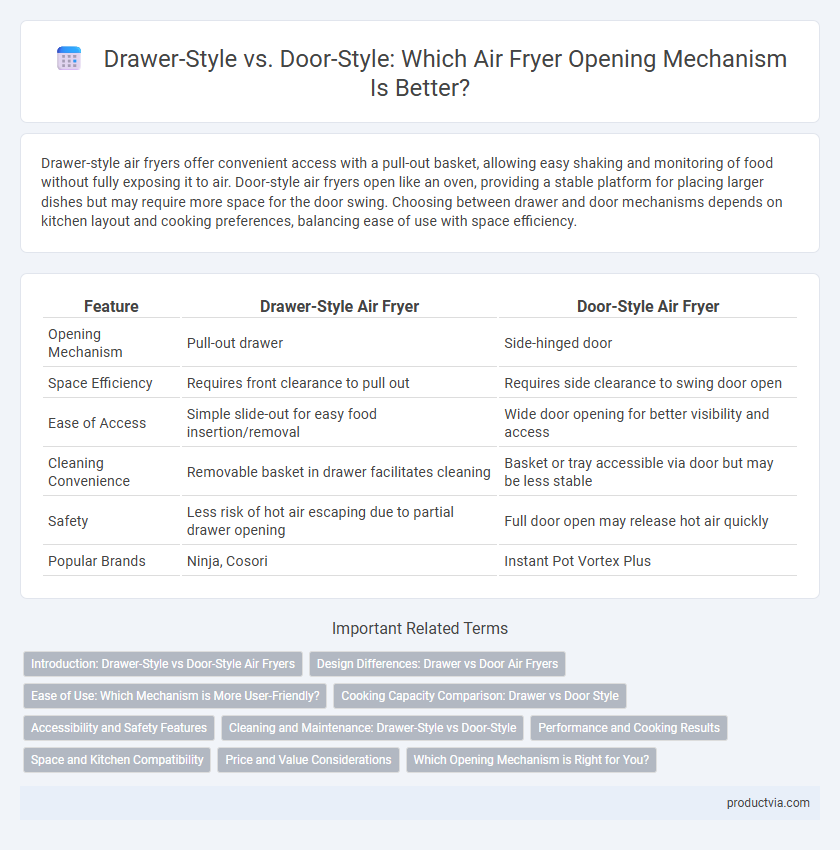Drawer-style air fryers offer convenient access with a pull-out basket, allowing easy shaking and monitoring of food without fully exposing it to air. Door-style air fryers open like an oven, providing a stable platform for placing larger dishes but may require more space for the door swing. Choosing between drawer and door mechanisms depends on kitchen layout and cooking preferences, balancing ease of use with space efficiency.
Table of Comparison
| Feature | Drawer-Style Air Fryer | Door-Style Air Fryer |
|---|---|---|
| Opening Mechanism | Pull-out drawer | Side-hinged door |
| Space Efficiency | Requires front clearance to pull out | Requires side clearance to swing door open |
| Ease of Access | Simple slide-out for easy food insertion/removal | Wide door opening for better visibility and access |
| Cleaning Convenience | Removable basket in drawer facilitates cleaning | Basket or tray accessible via door but may be less stable |
| Safety | Less risk of hot air escaping due to partial drawer opening | Full door open may release hot air quickly |
| Popular Brands | Ninja, Cosori | Instant Pot Vortex Plus |
Introduction: Drawer-Style vs Door-Style Air Fryers
Drawer-style air fryers feature a pull-out basket design that provides easy access and allows users to check food without fully opening the appliance, ensuring even cooking and minimal heat loss. Door-style air fryers open like an oven, often with a larger capacity and better visibility through a glass door, making them ideal for cooking multiple items simultaneously. Choosing between the two depends on user preference for convenience, capacity, and cooking style.
Design Differences: Drawer vs Door Air Fryers
Drawer-style air fryers feature a pull-out basket design that allows for easy access and convenient food loading, optimizing space with a compact footprint. Door-style air fryers open like an oven, providing a larger cooking cavity ideal for bigger meals and allowing the basket to remain inside while shaking or checking food. The design differences influence usability, capacity, and kitchen countertop space utilization, making drawer models more suitable for smaller kitchens and door-style models preferable for families or larger cooking batches.
Ease of Use: Which Mechanism is More User-Friendly?
Drawer-style air fryers offer a straightforward pull-out basket that simplifies access to food, making it easier to check and shake items during cooking. Door-style models feature a side-opening door that can require more clearance space, potentially limiting placement options but providing a stable platform when open. Users tend to find drawer-style mechanisms more user-friendly for quick, convenient access and safer handling of hot food baskets.
Cooking Capacity Comparison: Drawer vs Door Style
Drawer-style air fryers generally offer larger cooking capacities due to their wide, pull-out trays, allowing for even heat distribution and easy access to food. Door-style air fryers typically have smaller interiors as the basket swings out vertically, which can limit batch sizes and reduce overall volume. Consumers prioritizing cooking capacity and versatility often prefer drawer-style models for preparing larger meals or multiple ingredients simultaneously.
Accessibility and Safety Features
Drawer-style air fryers offer enhanced accessibility with their pull-out trays that allow easy insertion and removal of food, minimizing the risk of spills or burns. Door-style air fryers often incorporate locking mechanisms and cool-touch handles to improve safety by preventing accidental opening during cooking. Both designs prioritize user safety, but drawer-style models provide more convenient access, especially for individuals with limited hand strength or dexterity.
Cleaning and Maintenance: Drawer-Style vs Door-Style
Drawer-style air fryers offer easier cleaning and maintenance due to their removable baskets and non-stick surfaces, allowing quick access and thorough washing. Door-style air fryers typically have fixed trays, which may require more effort to clean but often provide a more compact design. Regular cleaning of both styles ensures optimal performance and longevity by preventing oil buildup and residue accumulation.
Performance and Cooking Results
Drawer-style air fryers provide more even air circulation, resulting in consistent cooking and crispier textures due to their removable basket design. Door-style models often feature larger cooking chambers, allowing for greater capacity and even heat distribution, which enhances cooking performance for bigger meals. Both designs impact heat retention and ease of access, directly influencing cooking efficiency and final food quality.
Space and Kitchen Compatibility
Drawer-style air fryers offer compact, horizontal access ideal for narrow kitchen spaces and under-counter installations, maximizing countertop efficiency. Door-style models require front clearance for swing-open access, demanding more space but providing easier maneuverability for larger food items. Selecting between the two depends on kitchen layout, with drawer-style favored for tight spaces and door-style suited for spacious countertops.
Price and Value Considerations
Drawer-style air fryers typically cost more upfront but offer better value through ease of access and uniform cooking performance, making them ideal for frequent use. Door-style models are generally more affordable and compact, appealing to budget-conscious buyers with limited kitchen space. The choice depends on balancing initial expenditure against long-term convenience and efficiency benefits.
Which Opening Mechanism is Right for You?
Drawer-style air fryers offer easy access and space-saving convenience, making them ideal for kitchens with limited countertop area. Door-style air fryers provide a traditional oven-like experience with a clear view of the cooking process, suitable for those who prioritize monitoring their food. Choosing between drawer-style and door-style depends on your kitchen layout, cooking habits, and preference for accessibility or visibility.
Drawer-style vs Door-style for air fryer opening mechanism Infographic

 productvia.com
productvia.com